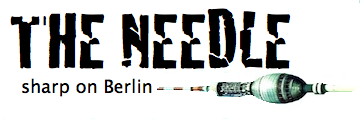State Security in No Man’s Land
Berliners are used to there being a great space off-limits between Mitte and Wedding, hidden behind a wall. The East German regime was most hated because of the way it inhibited freedom of movement and because of the Stasi’s invasion of private life. The knocking down of the wall was a symbolic moment in the change of ideologies. The building of a billion dollar complex to State Security where it stood sends quite a different message. We are walking down Chausseestraße, a rather bleak, treeless, avenue that runs through Mitte to Wedding. Here, at the juncture of the two districts, was a windy corridor, where the wall once stood.
(apologies, there have been mysterious formatting issues on this page! –the Editor)
A
It will have 6000 employees, as many as Germany’s more familiar face to the world, the Foreign Office. Founded by the CIA as “Organisation Gehlen”, it was a secret weapon at the beginning of the Cold War in the American Sector of occupied Germany. America’s pragmatic anti-Communism was more important than its anti-Fascism, and the CIA drew from members of the SS and Gestapo to fill the German intelligence service’s ranks. According to the CIA’s own figures, in the 1950s, up to 30% of the staff had been members of the Nazi party, and up to 8% members of Nazi paramilitary organisations like the SS or SA. The goal was to gather intelligence about the Soviet Zone. To keep activities secret from the other Allied powers, the project was stashed in a self-contained community in Pullach, just south of Munich. While its employees gathered intelligence, their families lived in isolation from normal society, on an island of schools and mensas housed in former Nazi buildings. This state secret only became officialised after a decade of existence, in 1956.
llects information from around the world on topics such as international terrorism, the international arms trade, drug trafficking and organised crime.The Pullach compound is now being moved to the capital and the new buildings will open in 2011. It’s costing the taxpayer 50 million euros for the land, and 800 million euro for the buildings. And what is the result?
the wall once stood, the very divide which motivated the BND’s founding and financing during Cold War times. When the crowds broke through the barriers and stood on the wall overlooking East Berlin in November 1989, I do not think they envisaged an organisation for State Security built on the death strip.

